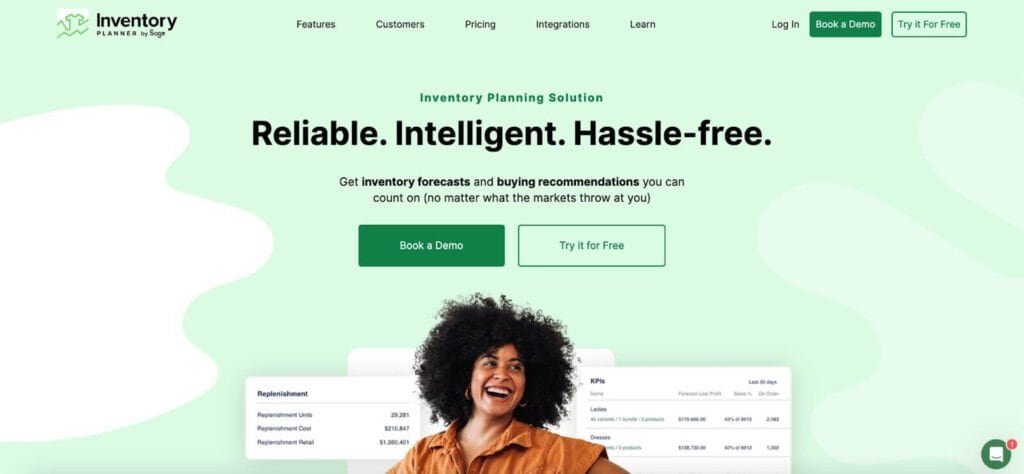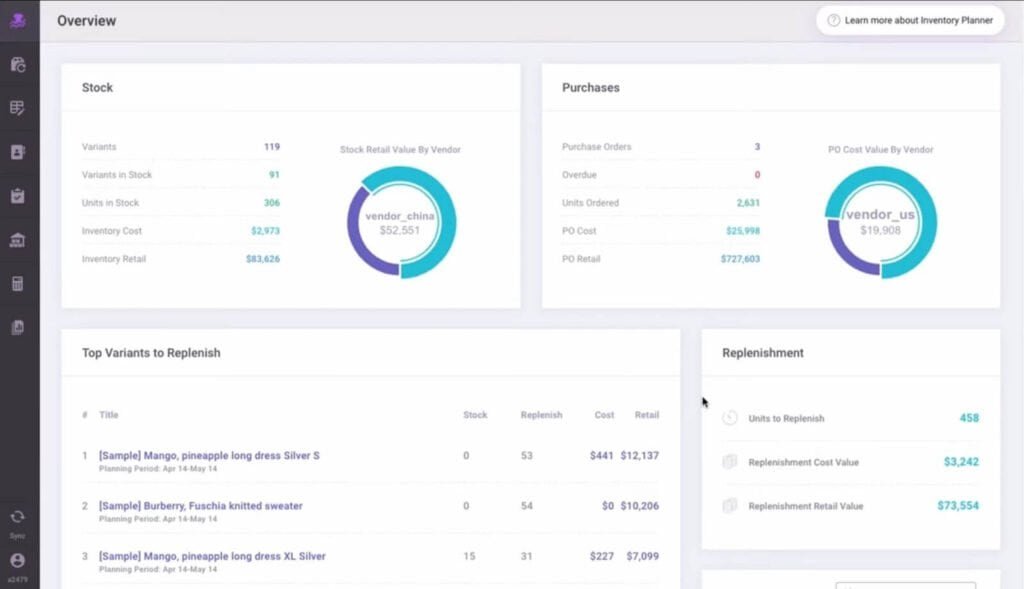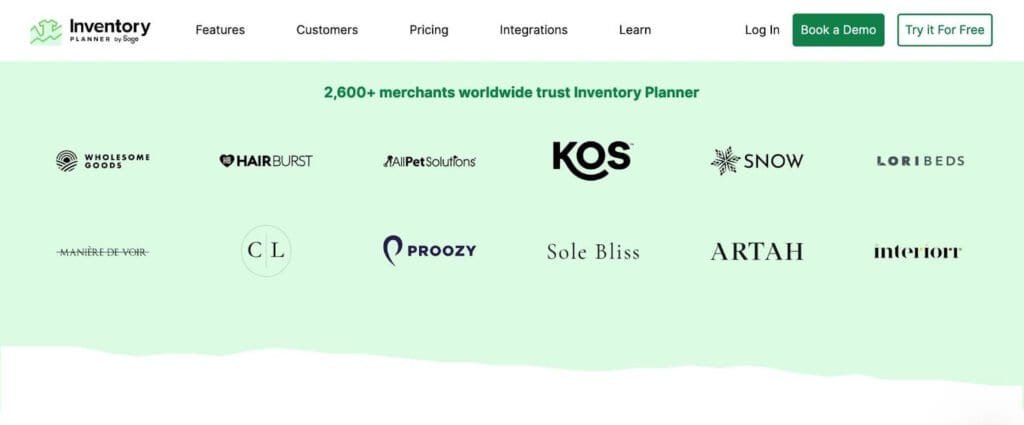Are you navigating stock management hurdles? The right Inventory Planner is your ally against overstock, stockouts, and cash flow bottlenecks. With a data-driven approach, they fine-tune your stock levels and procurement processes.
Our focus here is on inventory planners‘ strategies and tools to forecast demand, manage purchases, and wield data for operational efficiency – all pivotal in honing your competitive edge.

Key Takeaways
- Inventory Planners are integral to effective inventory control, utilizing data-driven approaches and automation to enhance forecasting, reduce overstock and stockouts, and improve purchasing decisions.
- Intelligent inventory planning significantly impacts cash flow by providing insights into inventory turnover, improving demand forecasting accuracy, and optimizing the business’s financial health.
- Inventory Planner adapts to the latest technologies and business needs with features like real-time alerts, seasonal trend analysis, e-commerce integrations, multiple warehouse support, and collaborative team efficiency tools.
Mastering Inventory Management: The Role of an Inventory Planner

- Identifying top-selling items
- Identifying dead stock
- Forecasting potential stock shortages before the next delivery
- Monitoring inventory KPIs
- Predicting cash flow
- Generating various reports
- Automating stock transfers and purchase orders
- Handling complex inventory forecasting
This ability to forecast future demand is what sets Inventory Planner apart.
Despite its higher cost, merchants find Inventory Planner a worthwhile investment. The time and money saved in inventory management, as well as the secure proceeding of inventory-related tasks, far outweigh the cost of the software.
Crafting the Perfect Purchase Order
Creating the perfect purchase order is an art. It involves determining the items to be purchased and the most favorable timing for those purchases, relying on dependable forecasts of future demand. In this process, Inventory Planners automate the creation of purchase orders, ensuring timeliness and underlining their significant role.
Data-Driven Purchasing Decisions
Data is the lifeblood of successful inventory management. Inventory Planners use data such as sales forecasting, customer demand, and sales trends to guide their purchasing decisions. This data-driven approach ensures businesses have the right products at the right time.
Data-driven purchasing offers several benefits for inventory management, including:
- Optimizing inventory levels
- Efficient resource allocation
- Minimizing carrying costs
- Maximizing storage space
- Mitigating risks
- Punctual procurement actions
This approach eliminates manual processes, is a critical component of successful inventory planning, and benefits the whole team involved in inventory management.
Reducing Overstock and Stockouts
Overstock and stockouts are two of the biggest challenges businesses face in inventory management. Factors such as inaccurate demand forecasting, ineffective inventory management, and sudden shifts in customer demand can lead to these issues.
Inventory Planners help businesses overcome these challenges by providing accurate demand forecasts and buying recommendations. This allows companies to determine the optimal inventory levels efficiently, avoiding overstocking and potential resource wastage and preventing stockouts that can result in lost sales and dissatisfied customers.
Enhancing Cash Flow Through Smart Inventory Planning
The benefits of intelligent inventory planning extend beyond just having the right products at the right time. It also has a significant impact on a business’s cash flow. By offering insights into inventory turnover and enhancing demand forecasting accuracy, Inventory Planners help companies optimize their cash flow.
Inventory Turnover Insights
Inventory turnover is crucial for assessing a company`s inventory management effectiveness. It’s calculated by dividing the cost of goods sold by the average inventory value over a specific period. A higher inventory turnover ratio increases liquidity, making more cash available to cover expenses.
Inventory Planner offers insights into the effect of inventory on cash flow, considering possible revenue losses from delayed replenishment and costs related to slow-moving products. These insights can help businesses make better inventory management decisions, release cash tied up in inventory, and improve their cash flow.
Demand Forecasting Accuracy
Accurate forecasting is a cornerstone of effective inventory planning. It involves predicting customer demand for an inventory item over a specific time frame, utilizing historical data, patterns, and known variables.
By using Inventory Planner, businesses can:
- Identify market trends
- Understand competitor strategies
- Forecast demand shifts
- Enhance the accuracy of demand forecasting
- Analyze historical data
- Identify patterns
- Make more accurate predictions
- Make better decisions about inventory, production, and marketing
- Ensure the availability of raw materials
- Minimize stockouts
- Prevent overstocking
Inventory Planner helps businesses optimize their inventory management and improve overall efficiency.
The Future of Demand Forecasting and Replenishment
As technology continues to evolve, so does the world of demand forecasting and replenishment. The future of this field involves advanced seasonality and trends analysis, as well as real-time alerts and notifications for better inventory management.
Seasonality and Trends Analysis
Seasonality and trend analysis is a vital part of demand forecasting. Monitoring seasonal sales performance and identifying seasonal trends can enhance seasonal forecasting accuracy. This approach offers numerous benefits, including:
- Improved inventory optimization
- Timely replenishment
- Avoidance of stockouts or overstocking
- Informed decisions about production, procurement, and marketing strategies
Understanding seasonal patterns and trends can ultimately lead to improved customer satisfaction, increased sales, and reduced costs.
Real-Time Alerts and Notifications
In today’s fast-paced business environment, real-time alerts and notifications are more important than ever. They enhance inventory replenishment strategies by offering precise data on reorder points, safety stock levels, and lead times while providing a unique ray ID for easy tracking and identification.
It offers real-time alerts and notifications, which help businesses address customer concerns quickly, track supply chain movement, respond to IT events, and improve overall efficiency. This feature is a game-changer in inventory planning, allowing businesses to stay on top of their inventory management and make proactive, informed decisions.
Customizing Your Inventory Management Experience
Every business is unique, and so are its inventory management needs. That’s why Inventory Planner offers the ability to customize your inventory management experience. Whether integrating with e-commerce platforms or adapting to multiple warehouse locations, Inventory Planner has covered you.
Inventory Planner is used by 2,600+ brands worldwide in every industry and niche imaginable.
Integration with E-commerce Platforms
In today’s digital world, e-commerce integration is not an option; it’s a necessity. Inventory Planner allows efficient multi-channel inventory management by integrating with popular e-commerce platforms such as:
This integration provides several advantages:
- Enhances order tracking
- Improves customer service
- Expands marketing capabilities
- Optimizes operations
- Ensures seamless data sharing
By automating the updating of inventory numbers, orders, and product details across multiple platforms, Inventory Planner enables businesses to make informed buying decisions and improve their management of stock levels.
Adapting to Multiple Warehouse Locations
Managing inventory across several warehouse locations can be complex, but Inventory Planner simplifies this task. The software offers the following features:
- Advanced tools and strategies to adjust to multiple warehouse locations
- Accurate demand forecasts for each location
- Purchasing recommendations tailored to each location
With Inventory Planner, you can effectively manage your inventory across multiple warehouses.
Geographic location can have a significant impact on inventory planning. It can influence the proximity of customers, thereby affecting the inventory management level and turnover rate. Using geolocation technology, Inventory Planner helps businesses minimize stockouts and enhance sales.
Empowering Teams with Collaborative Inventory Planning

Collaboration is critical to successful inventory planning. With Inventory Planner, teams can collaborate efficiently thanks to user-friendly dashboards and streamlined communication.
User-Friendly Dashboards
User-friendly dashboards, integral to effective inventory management, offer real-time visibility into inventory levels, including available stock, goods on order, and backorders. This visibility aids in accurately predicting stock levels and quickly fulfilling client orders through a secure www platform.
Inventory Planner offers these user-friendly dashboards, which enhance the following:
- Inventory control
- Forecasting and projection
- Sales order fulfillment
- Record keeping
Inventory Planner enables businesses to track their inventory more efficiently and make better decisions by providing a hassle-free, user-friendly interface and tools for organizing categories seamlessly.
Streamlined Communication for Faster Decision Making
Communication is vital in inventory planning. With streamlined communication, businesses can ensure efficient site connections with suppliers and provide precise, up-to-date inventory information.
Inventory Planner allows businesses to benefit from streamlined communication. The software offers dependable inventory systems that monitor stock levels and incorporate demand forecasting, ensuring decisions are based on current and future inventory needs. This results in better collaboration, proactive decision-making, and enhanced agility in inventory management.
There is also a greater emphasis on marketing and ways to take your business to new heights. Beyond inventory forecasting, it aims to help you build a brand that resonates with your target audience. Specific integrations with Google Analytics let you optimize your storefront by aligning your sales metrics with your marketing efforts, helping amplify your reach in a way few inventory planning tools can.
Inventory Planner Pros and Cons
Inventory Planner Pros
- Optimized Stock Levels: Inventory planners help businesses maintain optimal stock levels by analyzing demand patterns, reducing excess inventory, and preventing stockouts. This ensures efficient use of resources and minimizes holding costs.
- Improved Forecasting: These planners utilize advanced forecasting algorithms to predict demand accurately. This helps businesses plan production, procurement, and distribution more effectively, reducing the likelihood of overstock or understock situations.
- Enhanced Efficiency: By automating various inventory management tasks, planners streamline processes and reduce the manual workload. This improves overall operational efficiency and allows teams to focus on more strategic aspects of the business.
- Cost Savings: Effective inventory planning helps minimize carrying costs, obsolescence, and other expenses associated with excess inventory. By aligning supply with demand, businesses can achieve significant cost savings and optimize their financial performance.

Inventory Planner Cons
- Complex Implementation: Implementing inventory planning systems can be complicated and require significant time and resources. Integrating such tools into existing business processes may temporarily disrupt operations and necessitate thorough staff training.
- Dependence on Accurate Data: Inventory planners heavily rely on accurate and up-to-date information. If the input data is accurate and complete, the forecasting and planning may be flawed, leading to suboptimal inventory decisions.
- Initial Costs: Acquiring and implementing an inventory planning system often involves upfront costs, including software licenses, hardware, and possibly consulting fees. These initial expenses can hinder smaller businesses or those with tight budgets from adopting such systems.
Wrapping Up and My Experience With Inventory Planner
In conclusion, mastering inventory management is complex, but it becomes much more manageable with the right tool like Inventory Planner. From crafting the perfect purchase order to enhancing cash flow through intelligent inventory planning, Inventory Planner provides businesses with the tools they need to succeed.
As technology continues to evolve, so does the world of inventory planning. With features like real-time alerts and notifications, e-commerce integration, and the ability to adapt to multiple warehouse locations, Inventory Planner is well-equipped to meet businesses’ future needs.
FAQ
An inventory planner is responsible for optimizing inventory levels and ensuring the right amounts of products are ordered regularly. They help organizations develop and manage inventory plans, especially in manufacturing.
Inventory Planner enhances cash flow by providing insights into inventory turnover and improving demand forecasting accuracy, ultimately helping businesses optimize supply chain management and reduce excess stock.
Inventory Planner assists in crafting the perfect purchase order by determining what items to purchase and the most favorable timing for those purchases based on reliable forecasts of future demand.
Inventory Planner is a sophisticated software designed to help businesses effectively manage inventory through accurate forecasting.
The main difference is that a demand planner focuses on forecasting customer orders, while an inventory planner manages stock levels to meet those orders. Demand planning involves predicting product market demands, which determines inventory management decisions.



